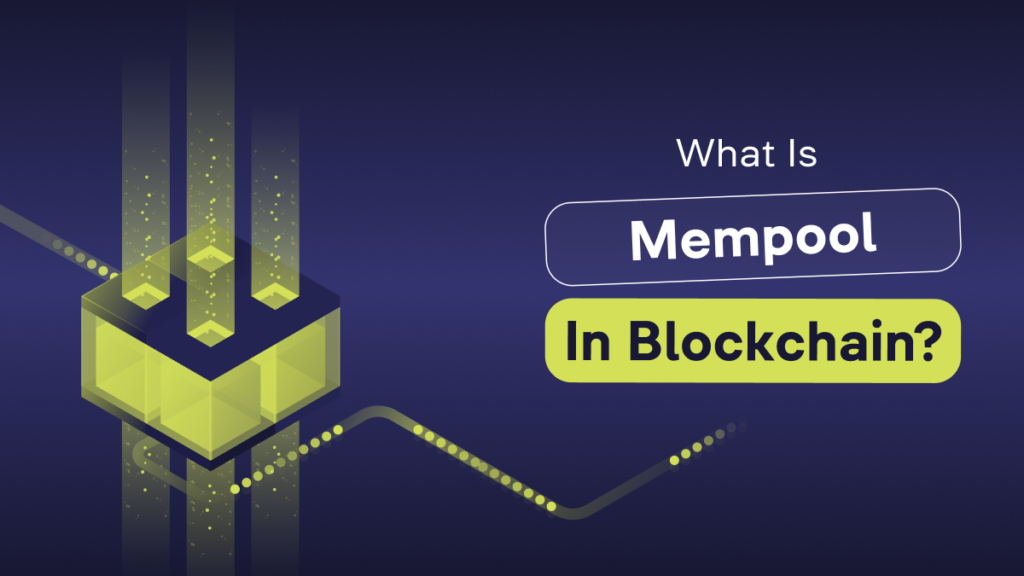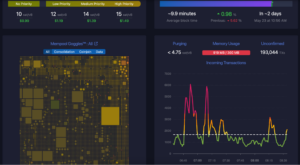What Is Mempool In Blockchain?

Content
Have you ever wondered what happens to a transaction before it hits the blockchain? On the blockchain, each transaction goes through several stages until it becomes part of an immutable chain. One of the first steps is getting into the mempool. What is a mempool in cryptocurrency? How does a mempool work? Why is it important? Our article answers these questions.
Mempool Meaning In Simple Words
Mempool is a special storage area on the blockchain containing all unconfirmed transactions waiting to be included. When a user submits a transaction, it first enters the mempool and is awaiting processing. Each node on the blockchain network maintains its mempool, which serves as a buffer between sending a transaction and its inclusion in the block.
A mempool is a “waiting room” on a blockchain node. The term consists of the words “memory” and “pool”.
The mempool plays a key role in managing and prioritizing transactions. Miners usually select transactions from the mempool based on the size of commissions: transactions with higher commissions have a higher priority. They are, therefore, faster to be included in the block. If the mempool overflows due to many unconfirmed transactions, wait times can increase significantly, and commissions can rise. Mining becomes more competitive as miners try to choose the most profitable transactions. They understand how mempool works, essential for those who want to trade cryptocurrency.
How Does The Mempool Explorer Work?
Mempool Explorer is a tool that helps users monitor and analyze the state of the mempool in real time. There are many blockchain explorers; one of the most popular is mempool.space. Let’s take a look at how it works:
- Data collection: Mempool Space connects to nodes on the blockchain and collects information about all unconfirmed transactions. This includes transaction size, fees, sending time, mempool chart, and other metadata.
- Analysis and visualization: The collected data is analyzed and presented in a convenient visual form. Users can see the total number of unconfirmed transactions, average and maximum commissions, and the current load on the network. This makes it easy to assess the current situation in the mempool and make decisions regarding sending transactions.
Visualization of mempool data. Source: mempool.space
- Filtering and sorting: Mempool Explorer provides tools for filtering and sorting transactions by parameters such as fee size, waiting time, and other criteria. This helps users find the most appropriate transactions to include in a blockchain or evaluate their performance.
- Real-time update: One of the critical features of Mempool Explorer is real-time data updates. This allows users to get up-to-date information about the status of the mempool and respond quickly to changes in the network.
Importance Of Mempool In Blockchain Transactions
The mempool plays a critical role in blockchain transactions by performing several vital functions:
- Buffer for unconfirmed transactions: The mempool serves as temporary storage for all transactions initiated but has yet to be confirmed and included in the blockchain. This allows the network to manage the flow of incoming transactions efficiently.
- Transaction Prioritization: In the mempool, transactions are sorted by fee. Miners tend to favor those that offer higher commissions when selecting a transaction ID (TxID) for inclusion in the next block. This incentive encourages users to offer competitive commissions to process their transactions faster.
- Network Monitoring: The state of the mempool provides important information about the current workload on the network. If it is complete, it may indicate high levels of activity or spam attacks. Analyzing mempool data helps miners and users better understand and respond to changes in the network.
- Node Optimization: Blockchain nodes use a mempool to optimize transaction processing. By maintaining a transaction queue in the mempool, nodes can efficiently allocate resources and schedule work, which improves overall network performance.
- Transparency and Audit: Mempool provides transparency of transactions before they are incorporated into the blockchain. Many cryptocurrencies utilize this mechanism to improve transparency and security. Users can track their transactions, check their status, and estimate the confirmation time. This increases trust in the system and makes it easier to audit transactions. All cryptocurrencies have unique transaction management and validation mechanisms, allowing the process to be customized to different needs and network characteristics.
Mempool in BTC and ETH Networks
Memepools are essential to the Bitcoin (BTC) and Ethereum (ETH) networks. Although the primary function of mempools in both networks is similar, there are some differences in their features and working principles. Let’s look at these differences in more detail.
Bitcoin Mempool
BTC Mempool stores all unconfirmed transactions that have been sent but not yet included in the blockchain. This temporary storage allows blockchain nodes to manage transactions until they are confirmed efficiently. In the BTC mempool, transactions are sorted by fee. When selecting transactions to include in the block, miners usually prefer those that offer higher commissions, allowing them to maximize their profits. When a node receives a new transaction, it checks it against the network’s rules and sends it to the bitcoin mempool congestion if the transaction is valid. In the mempool, transactions are sorted by fees, and miners choose the most profitable ones to include in the next block. Bitcoin remove transaction from mempool once a transaction is included in a block. When it is removed from the mempool crypto, it makes room for new transactions.
Ethereum Mempool
Unlike Bitcoin, the Ethereum network supports more complex transactions, including smart contracts. Mempool ETH stores both regular transactions and transactions related to the execution of smart contracts. On the Ethereum network, the priority of transactions is determined by the gas fees users are willing to pay. Higher Gas Fees increase the chances of a transaction being confirmed quickly. The Ethereum price can also affect network activity, as higher fees can incentivize users to make more frequent transactions.
Nodes on the Ethereum network accept new transactions, check their validity, and add them to the mempool. The size of the gas fee sorts mempool transactions. Miners select transactions with the highest gas fees to maximize their profits. Once a transaction is executed and included in the blockchain, it is removed from the mempool ETH.
Etherscan mempool is a popular resource for monitoring transactions and the health of the Ethereum network, including the ETH Mempool.
ETH mempool. Source: etherscan.io
Understanding how the ETH mempool explorer works across different networks helps to navigate the transaction confirmation process to optimize its cost and waiting time better. For a deeper understanding of blockchain and transactions, it’s crucial to know what a blockchain hash is, which ensures the security and immutability of data within the network.
Mempool Congestion: How do you withdraw Bitcoin from Mempool?
When the Bitcoin network’s mempool is overloaded, unconfirmed transactions spike sharply, leading to a backlog of transactions waiting for confirmation. This typically occurs during peak network usage when numerous users send transactions simultaneously.
The price of BTC often fluctuates during periods of mempool congestion, which can increase user activity. As a result, miners cannot process all the transactions, significantly expanding the confirmation wait time. Since transactions with higher mempool fees are prioritized, users raise their fees to get their transactions processed faster, increasing the average network fee.
Transactions in the mempool cannot be revoked, but they can be replaced using two methods:
- Replace-by-Fee (RBF): To utilize RBF, you must create a new transaction with the same input and output addresses but specify a higher fee. The latest transaction will replace the original one in the mempool, and miners are more likely to include it in the next block.
- Double Spend with Increased Fee: If a transaction does not support RBF, you can attempt to create a double spend with a higher fee. However, this method requires special skills and only sometimes guarantees success, as miners may reject the double spend.
These methods help expedite transaction confirmation when the mempool is overloaded, ensuring fast transaction processing even during high network traffic. Those learning how to trade crypto should consider these methods to enhance the efficiency of their transactions and minimize delays.
Consequences of Mempool Overload
- Increased Confirmation Time: Transactions with low fees can be delayed indefinitely, making the network less convenient for users, especially those unwilling to pay high fees.
- Fee Increase: Users aiming to expedite the confirmation of their transactions set higher fees, leading to an overall increase in network fees.
- Transaction Delays: Transactions waiting in the mempool for extended periods can create inconveniences, especially in situations requiring urgent confirmation.
Conclusion
The mempool in the blockchain is a temporary storage for unconfirmed transactions in various blockchain networks, including Bitcoin and Ethereum. Bitcoin mempool size is vast: mempool bitcoin transactions are sorted by the fee users are willing to pay. In Ethereum, a similar mechanism works through the gas fee, determining transaction priority. Both systems use fees to sort transactions, though they refer to them differently.
The mempool is crucial because it efficiently manages unconfirmed transactions and their priority, ensuring smoother network operation. Mempool overload can slow down transaction confirmation, especially during periods of high network activity. One can use the RBF mechanism or double spending with a higher fee to speed up transactions. These methods help confirm transactions faster, minimize delays, and understand how the mempool works, which is essential for effectively managing cryptocurrency operations, particularly for those interested in cryptocurrency trading.












